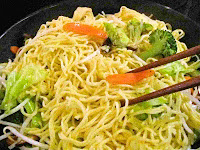<Ingredients>
Large handful vegetables and mushrooms (3 cabbage leaves, 1 small carrot, tiny handful broccoli, small handful moyashi bean sprouts, 3 shiitake mushrooms in photo)
3 tbsp soy sauce
1 tbsp oyster sauce
Salt & pepper, to taste (not in photo)
2 tsp oil (not in photo)
<Directions>
1.
Thinly slice carrot diagonally. Divide broccoli into small florets. If using stems, peel thickly, and slice or dice. Slice shiitake.
Cut cabbage into 3cm squares. Sogigiri slice white sections of cabbage at a slant.
Remove skinny roots and damaged/softened parts of moyashi.
2.
Pour warm or hot water over noodles and fluff them up.
3.
In a frying pan, heat oil, and saute vegetables, starting with the firmest or those that take the longest to cook.
Here, carrot and white firm sections of cabbage are sauteed first, followed by broccoli and shiitake, and then cabbage.
When cabbage is almost done, add salt and pepper, and keep sauteing.

When vegetables are almost done, add moyashi, and saute.
4.
Add noodles, and mix.
Cover and steam for 1 or 2 minutes until noodles are somewhat soft.
5.
Mix oyster sauce and soy sauce.
(This is unnecessary; it ensures even flavoring.)
Swirl in soy sauce and oyster sauce mixture, and mix well.
Ready to serve.
<Notes>
- If using dried noodles, first boil them according to the package instructions.
- When cooking outdoors or when warm/hot water to fluff up noodles beforehand is unavailable, place noodles on top of vegetables and cover (moisture from vegetables helps to fluff up noodles), or add a little water or beer from the bottle you’re holding and stir (adding extra liquid helps the steaming effect, even without a cover).
- Cabbage is almost always found in yakisoba noodles. Carrots are common. You can throw in any vegetable you find in the fridge.
- If meat or seafood (typically prawns or calamari) is added, saute it first.
- Top with thinly sliced nori seaweed, toasted white sesame seeds or aonori seaweed (optional).
- At restaurants or from food stands, yakisoba is often accompanied with benishoga pickled ginger.
- Add 1 tbsp mirin for somewhat richer and sweeter flavor.














No comments:
Post a Comment